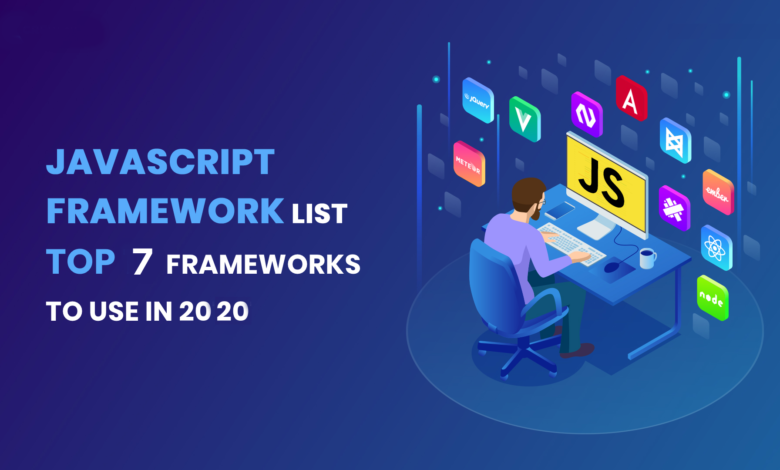
JavaScript has completely taken over the web development world. Whether you’re building websites, apps for phones, or backend servers, chances are you’re using JavaScript. But here’s the thing most developers struggle with: picking the right JavaScript framework for the job.
With so many options out there, it’s easy to feel overwhelmed. Do you need something powerful but complex? Or something simple and lightweight? So, today we will talk about selecting the best JavaScript framework to use JavaScript for your web app.
Read more: Computerized Marketing: A basic diagram for fledglings!
What is a JavaScript framework?
A JavaScript framework is basically an application framework that is scripted in JavaScript; it distinguishes itself from a JavaScript library in various forms. What makes JavaScript frameworks popular among developers is that they don’t need to call the code; the framework itself calls the code. This way, developers can develop their web apps quickly with reduced complexity.
A JS framework provides instant feedback to developers related to app development so that they can dynamically exchange data between a server and a website. Since its inception, there has been a lot of improvement in JavaScript frameworks with continuous updates.
Also, the broad developer community of JavaScript developers offers continuous support and security, patterns for faster completion of JavaScript projects, and pre-built functions that have made JavaScript frameworks more popular among developers.
So, what are the right JavaScript frameworks that you should look for in 2025?
After in-depth research, our team of experienced developers created this list of the right JavaScript frameworks to be used in 2025.
Why Does Your Framework Choice Matter?
Picking the right JavaScript framework isn’t just about personal preference. Your choice affects how fast you can build, how well your app performs, and how easy it is to maintain down the road. A good framework handles the boring stuff automatically so you can focus on building features instead of writing repetitive code.
Read more: Top 10 Online Learning Apps for Students
The Best JavaScript Frameworks for 2025
1. React
React remains the king of JavaScript frameworks, and for good reason. Created by Facebook and maintained by a huge community of developers, React has become the go-to choice for building everything from small websites to massive apps.
What makes React so popular is how it lets you break your app into small, reusable pieces called components. You write your code once and use it everywhere. React also uses something called the Virtual DOM, which makes apps super fast because it only updates the parts that actually changed.
React plays well with other tools and works for web apps, mobile apps, and even desktop applications. If you’re just starting out, React has endless tutorials and a massive community ready to help.
Best for: Building scalable web apps, mobile applications, and projects that need strong performance.
2. Vue.js
Vue.js is the scrappy underdog that’s been winning hearts since 2013. It’s easier to learn than React, and developers love how simple and straightforward it feels.
Vue handles everything in one place, which means less jumping around your code. It’s especially great if you’re building something that needs to update in real-time, like a chat app or a live dashboard. Plus, the file size is tiny compared to other frameworks, so your app loads faster.
The Vue community has grown a lot in recent years, and now you can find help and resources in almost any language. If you want something less overwhelming than React but still powerful, Vue is worth checking out.
Best for: Real-time applications, interactive user interfaces, and developers who like clean, readable code.
3. Angular
Angular is the enterprise powerhouse. It’s built for teams working on large, complex projects where you need structure and consistency.
Angular comes packed with everything you need to build full apps, which is great if you want everything in one place. It uses TypeScript, which helps you catch bugs before they become problems. The downside is that Angular has a steeper learning curve, and you might feel like you’re learning a lot just to build something simple.
Angular is super popular in big companies because it enforces good practices and scales well. If your team is using it or your company requires it, stick with it. Just know it takes more effort to learn.
Best for: Large enterprise projects, teams that need structure, and apps that need to handle complex features.
4. Next.js
Next.js is React with superpowers. It’s built on top of React but adds all the server-side features you actually need without having to set them up yourself.
With Next.js, you can build full-stack apps using just JavaScript, handle server rendering automatically, and get built-in performance optimizations. It’s become wildly popular for anyone who wants to use React but doesn’t want to spend days setting everything up.
If you know React already, jumping to Next.js is easy. Even if you’re new to React, Next.js is a smart choice because it guides you toward best practices.
Best for: Full-stack applications, content-heavy websites, and anyone building with React who wants fewer setup headaches.
5. Svelte
Svelte is the new kid that’s turning heads with a totally different approach. Instead of sending a big JavaScript bundle to the browser, Svelte compiles your code down to plain JavaScript that’s small and fast.
The syntax is clean and feels natural. You write less code, and the app still works better. Performance is genuinely excellent because there’s no framework overhead at runtime. The community is smaller than React or Vue, but it’s growing fast.
Svelte is perfect if you’re building something where performance really matters or if you just want to write cleaner code.
Best for: Performance-critical apps, small to medium projects, and developers who like fresh thinking.
6. Node.js
Node.js is different from the other frameworks on this list because it’s for the backend. It lets you use JavaScript on your server instead of switching to Python or Java.
Node.js is fast and can handle tons of requests at the same time. You can build APIs, real-time applications, and complex backends without leaving the JavaScript ecosystem. Plus, many projects use Node.js for tools and scripts behind the scenes.
Best for: Backend development, APIs, real-time applications, and building full-stack apps where JavaScript runs everywhere.
7. Astro
Astro is perfect if you’re building something like a blog, documentation site, or content-heavy website where performance is king.
Astro only sends HTML and CSS to the browser unless you specifically ask for JavaScript. This makes sites incredibly fast and great for SEO. You can mix and match different frameworks (React, Vue, Svelte) in the same project if you want.
It’s a newer framework, but it’s solving real problems for content creators and marketing teams.
Best for: Websites, blogs, documentation, and any project where SEO and speed are priorities.
How to Pick the Right One
Here’s a simple way to think about it:
-
Choose React if you want the biggest community, tons of jobs in the market, and flexibility for almost any project.
-
Choose Vue if you want something easier to learn but still professional and powerful.
-
Choose Angular if you’re working in an enterprise environment or on a huge project where structure matters.
-
Choose Next.js if you’re building a full-stack application and want React with less complexity.
-
Choose Svelte if performance and clean code are your top priorities.
-
Choose Astro if you’re focused on content and need a super-fast website.
-
Choose Node.js if you’re building the backend of your application.
Final Thoughts
The best JavaScript framework is the one that fits your project needs and your team’s skill level. React dominates for a reason, but Vue, Angular, and the newer options all solve real problems.
Before you choose, think about what you’re building, how much time you have to learn, and what your team already knows. Don’t stress too much about picking the perfect one. Most frameworks are good enough for most projects. Pick one and start building.












One Comment